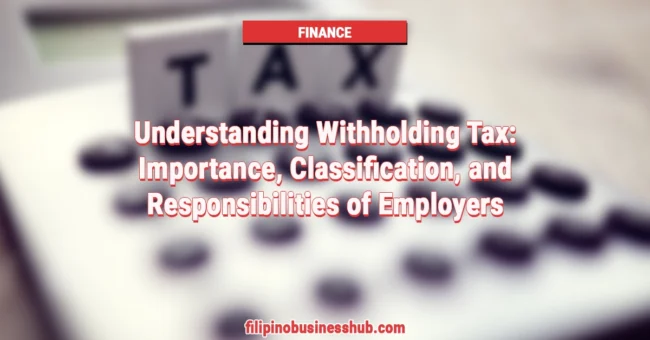Understanding Withholding Tax: Importance, Classification, and Responsibilities of Employers
What is Withholding Tax Philippines
The withholding tax system is an efficient method governments use to collect taxes at source from individuals, corporations, and government agencies. Under this method, a withholding agent deducts and remits a specified percentage of withheld tax from payments due to payees who may later file for refund or credit of this withholding tax amount withheld from payments due them; once this deduction occurs, it can encourage voluntary compliance while also reducing collection effort costs, preventing delinquencies and revenue loss, providing revenues throughout the taxable year thus providing governments a stable financial future.

Table of Contents
Who is required to withhold withholding taxes?
- Individuals engaged in business or the practice of the profession
- Non-individuals (corporations, associations, partnerships, cooperatives) whether engaged in business or not
- Government agencies and their instrumentalities (National Government Agencies (NGAs), Government-owned or Controlled Corporations (GOCCs), Government Units including Barangays (LGUs)
- A Withholding Agent – any person or entity who is in control of the payment subject to withholding tax and therefore required to deduct and remit taxes withheld to the government.
What are the different types of withholding taxes?
- Creditable withholding tax
- Compensation
- Expanded
- Withholding Tax on GMP – Value Added Taxes (GVAT)
- Withholding Tax on Government Money Payments (GMP) – Percentage Taxes
- Final withholding tax
Compensation or wages refers to all remuneration for services performed by an employee for his employer under an employee-employer relationship, except where exempted by National Internal Revenue Code (NIRC) and pertinent laws. Below are examples of compensation:
- Regular
- Basic salary
- Fixed allowances
- Supplementary
- Commission
- Overtime pay
- Fees, including directors’ fees
- Profit sharing
- Monetized vacation leave over ten (10) days
- Sick leave
- Fringe benefits received by rank-and-file employees
- Hazard pay
- Taxable 13th-month pay and other benefits
- Other remuneration received from an employee-employer relationship
What are employers’ responsibilities regarding withholding tax?
- Submit the duly accomplished BIR Form Nos. 1902 and/or 1905 to the RDO within thirty (30) days from receipt;
- Withhold the tax due from the employees following the prescribed manner;
- Remit the amount of tax withheld from the employee within the prescribed due dates;
- Do the year-end adjustment;
- Submit Annual Information return (BIR Form 1604-C, 1604-F, and 1604-E), including the required alphabetical list of employees/payees on or before January 31 following the close of the calendar year;
- Issue the Certificate of Compensation Payment/Tax Withheld (BIR Form No. 2316) to the employees; and
- Refund excess tax withheld.
Exemptions and exclusions from gross income exist as well, such as any remuneration received as part of employment, agricultural labor compensation paid out, domestic services compensation received, and services rendered for foreign governments or international organizations by citizens and residents of the Philippines, etc.
Employers must ensure they comply with all relevant regulations regarding withholding taxes to avoid penalties and legal issues related to withholding. Although minimum wage earners do not fall under this tax obligation, employees in the public sector with compensation income not exceeding the Statutory Minimum Wage are subject to withholding. Furthermore, minimum wage earners who work in private sector industries do not face withholding tax obligations.
However, public sector employees with compensation income below the Statutory Minimum Wage may still owe withholding tax. Therefore, employers must ensure compliance to avoid penalties and potential legal implications from these taxes being withheld from employees in public sector jobs that fall within this withholding obligation – penalties could result in legal liabilities for both parties involved.
